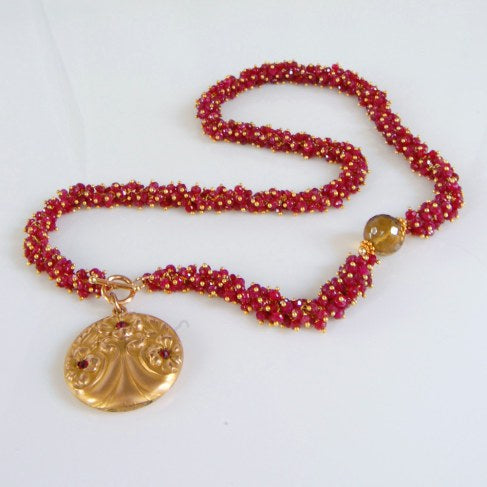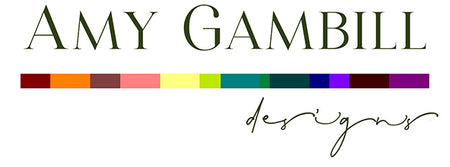Rubies are a corundum, same as sapphires. However, rubies are designated as the red shades of corundum ranging from having tints of pink, purple, orange and brownish-red. The chromium and iron content of the stone is what affects the varying shades of red a ruby may possess. The trace mineral content tends to vary with the geologic formation which produced the ruby, so original place designations such as Burmese and Thai have come in later years to be sometimes used in describing color. 
So, what makes a ruby a ruby and not a sapphire? Generally, rubies are of the medium to medium dark variety of red hued corundum gemstones. Stones that have a lighter or more pinkish tone are what we know as pink sapphires. However, there is no distinct designation as to where the line is drawn between a pinkish hued corundum being ruby or sapphire. The adage goes, "Whether it's a ruby or a pink sapphire depends on whether you're the buyer or the seller."
Rubies are extremely wearable. With a Mohs hardness scale rating of nine, they are excellent gemstones for jewelry pieces that might take more of a beating, such as rings and bracelets. A diamond, at four times greater hardness is the standard for the Mohs scale with a rating of 10. Almost all corundum gems typically receive some manner of treatment to enhance their color, some treatments being more acceptable than others. Generally heat treatment, which mimics the natural processes found in nature to further enhance natural gemstones is used. Unless a seller specifically indicates a ruby is not heat treated, you should assume it is. Heating is used to clarify a stone as well as improve color saturation and tone and is a permanent, stable process. While some stones can show signs of heat stress within the inclusions, in clean stones it is virtually impossible to detect whether the color is natural rather than heat enhanced. Simple heating is widely accepted and, as it is virtually indistinguishable from Mother Nature's own process, does not significantly lower the value of treated rubies. Other less desirable treatments include dying, diffusion coloring, or polymer or glass filling. When sourcing rubies for the necklace depicted here, I stumbled across some beautiful stones. However, from the moment I touched them, I knew something wasn't right. They had a cold feel and had a "tinkling" type noise as I ran my hands across the strands. I asked the dealer if they were treated and he confirmed they were glass permeated. Needless to say, I moved on. Amy Holton Designs does not use dyed, lab created or artificially enhanced gems aside from those treatments which replicate nature's processes. Rubies certainly rank amongst the most valuable of corundum gemstones with larger gem quality stones being more rare than even diamonds of comparable size. Gem quality sapphires of a 1-3 carat size are in greater abundance than smaller rubies which, of course, increases the value of even smaller sized ruby gemstones. Rubies possess a quality called pleochroism which means that the color of the stone can change when viewed from different angles. A stone's geographic origin can sometimes be determined by the color of the stone itself. Burmese rubies tend toward purplish red colors and Thai stones have a more brownish red appearance. Additionally, many rubies will fluoresce in long or short wave UV and this property can often be used to help identify a stone's geographic origin. Burmese rubies often fluoresce so strongly that the effect is noticeable even in sunlight, such stones seem literally to glow, and are greatly admired. Thai stones generally lack this property. Although Asia has historically been the major producer of ruby gems, there are many other sources including the USA, Australia, and most recently Africa. Burmese stones tend to fetch the highest prices. Ruby lore states that the stones provide the owner protection from misfortune and ill health. Sanskrit writings tout the ruby as the most valuable of all gemstones. With their ultimate red color, they have symbolized passion and romance for centuries. Rubies, having the color of blood, also became symbols of courage in ancient times and warriors were said to have implanted them under the skin to bring invincibility and valor. As the science of gemology developed it became known that many historically important "rubies" such as the famed Black Prince's Ruby of the British Crown Jewels, were actually other red gems, most often red spinels. Aside from being the birthstone for lucky July babies, ruby is also the traditional recommended gem for couples celebrating 15th or 40th wedding anniversaries. However, you don't have to be July-born or wait for a 40th anniversary to warrant owning this gorgeous gemstone. As with all gemstone purchases, educate yourself, ask questions and seek out the best you can find within your budget. Rest assured, you'll have a piece that will proudly be passed on as an heirloom in the future.
Ruby lore states that the stones provide the owner protection from misfortune and ill health. Sanskrit writings tout the ruby as the most valuable of all gemstones. With their ultimate red color, they have symbolized passion and romance for centuries. Rubies, having the color of blood, also became symbols of courage in ancient times and warriors were said to have implanted them under the skin to bring invincibility and valor. As the science of gemology developed it became known that many historically important "rubies" such as the famed Black Prince's Ruby of the British Crown Jewels, were actually other red gems, most often red spinels. Aside from being the birthstone for lucky July babies, ruby is also the traditional recommended gem for couples celebrating 15th or 40th wedding anniversaries. However, you don't have to be July-born or wait for a 40th anniversary to warrant owning this gorgeous gemstone. As with all gemstone purchases, educate yourself, ask questions and seek out the best you can find within your budget. Rest assured, you'll have a piece that will proudly be passed on as an heirloom in the future.
The regal ruby necklace featured in this post is comprised of over 700 individual rubies poised on 24 karat vermeil headpins and hand-linked, one by one. It was a piece I nursed for over two years. I just couldn't decide exactly how I wanted to finish it until I found this amazing circa 1920s gold-filled locket. The piece made it's debut at a trunk show I did here in Austin and sold within 30 minutes. It was such a labor of love and in my possession for such a short time after finishing it, I had to blink back tears as I placed it in its rosewood box and handed it over to the purchaser. It filled me up to know it was beautiful gift for her mother to which we added a pair of custom earrings to match.
So, whether you're July-born, celebrating a milestone anniversary or simply love jewelry, wear your rubies proudly. And always remember, don't set them aside, only to be taken out on special occasions. Nothing looks more classic than a basic white shirt accented with fabulous gemstone jewelry!
Happy birthday, July-born readers!!
